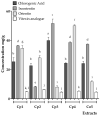Intra- and Interspecies Differences of Two Cecropia Species from Tabasco, Mexico, Determined through the Metabolic Analysis and 1H-NMR-Based Fingerprinting of Hydroalcoholic Extracts
- PMID: 37447001
- PMCID: PMC10346827
- DOI: 10.3390/plants12132440
Intra- and Interspecies Differences of Two Cecropia Species from Tabasco, Mexico, Determined through the Metabolic Analysis and 1H-NMR-Based Fingerprinting of Hydroalcoholic Extracts
Abstract
The genus Cecropia is used in the traditional medicine of Tabasco, Mexico, in diabetes and hypertension treatments, mainly without distinction of the species. This contribution aimed to carry out the metabolic analysis and Proton Nuclear Magnetic Resonance (1H-NMR) spectroscopy-based fingerprinting of the hydroalcoholic leaf extracts of Cecropia peltata (Cp) and Cecropia obtusifolia (Co) collected in five sub-regions of the State of Tabasco (Cp1, "Centro"; Cp2, "Chontalpa"; Cp3, "Pantanos"; Cp4, "Ríos" and Co5, "Sierra"). Firstly, the extracts were evaluated for their Total Phenol Content (TPC) and Total Flavonoid Content (TFC) by spectrophotometric methods. In addition, metabolic analysis was performed using High-Performance Liquid Chromatography with Diode-Array Detection HPLC-DAD, which allowed the quantification of the chemical markers: chlorogenic acid, isoorientin, and orientin, as well as a vitexin analog. Finally, metabolomic analysis was carried out based on the 1H-NMR spectra. The Cp4 extract (C. peltata from the "Ríos" sub-region) presented the highest values of TPC (155 ± 9.1 mg GAE/g E) and TFC (724 ± 22.2 mg RE/g E). The metabolic analysis was similar among the five samples; the highest concentrations of the four chemical markers were found in Cp3 (C. peltata from the "Pantanos" sub-region) for chlorogenic acid (39.8 ± 2.3 mg/g) and isoorientin (51.5 ± 2.9 mg/g), in Cp4 for orientin (49.9 ± 0.6 mg/g), and in Cp2 (C. peltata from the "Chontalpa" sub-region) for the vitexin analog (6.2 ± 0.2 mg/g). The metabolic analysis and the 1H-NMR fingerprint analysis showed intraspecies differences among the C. peltata samples and interspecies between C. peltata and C. obtusifolia, which were attributed to variations in the metabolite groups as well as in the proportion of sugars such as glucose and xylose.
Keywords: Cecropia obtusifolia; Cecropia peltata; chemical markers; metabolomic profile.
Conflict of interest statement
The authors declare no conflict of interest.
Figures






References
-
- Zheleva-Dimitrova D., Petrova A., Zengin G., Sinan K.I., Balabanova V., Joubert O., Zidorn C., Voynikov Y., Simeonova R., Gevrenova R. Metabolite profiling and bioactivity of Cicerbita alpina (L.) Wallr. (Asteraceae, Cichorieae) Plants. 2023;12:1009. doi: 10.3390/plants12051009. - DOI - PMC - PubMed
Grants and funding
LinkOut - more resources
Full Text Sources
Miscellaneous

